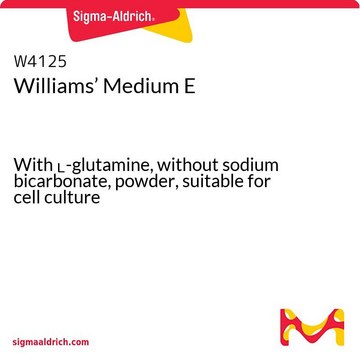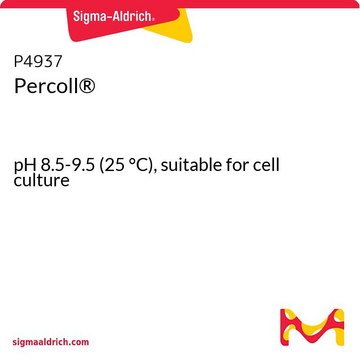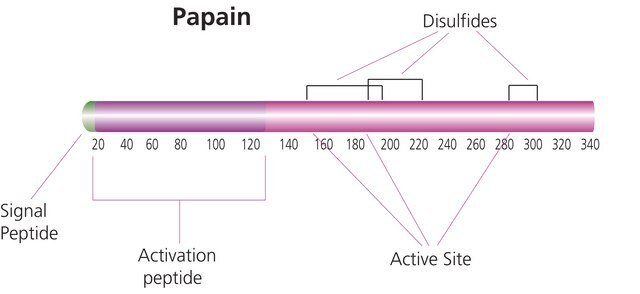W4128
Williams′ Medium E
With sodium bicarbonate, without ʟ-glutamine, liquid, sterile-filtered, suitable for cell culture
Sinonimo/i:
Williams’ E medium
Autenticatiper visualizzare i prezzi riservati alla tua organizzazione & contrattuali
About This Item
Codice UNSPSC:
12352207
NACRES:
NA.75
Prodotti consigliati
Nome del prodotto
Williams′ Medium E, With sodium bicarbonate, without L-glutamine, liquid, sterile-filtered, suitable for cell culture
Livello qualitativo
Sterilità
sterile-filtered
Stato
liquid
tecniche
cell culture | mammalian: suitable
Impurezze
endotoxin, tested
Componenti
L-glutamine: no
phenol red: 0.0107 g/L
glucose: 2.0 g/L (Dextro)
NaHCO3: 2.2 g/L
Condizioni di spedizione
ambient
Temperatura di conservazione
2-8°C
Descrizione generale
Williams′ Medium E has been shown to support the growth in long-term culture of adult liver epithelial cells.
Applicazioni
Williams′ Medium E has been used to culture primary human hepatocytes and to maintain hepatocellular carcinoma (JHH-6) cell lines.
Ricostituzione
Supplement with 0.292 g/L L-glutamine.
Comunemente ordinati con questo prodotto
N° Catalogo
Descrizione
Determinazione del prezzo
Supplemento
Codice della classe di stoccaggio
12 - Non Combustible Liquids
Classe di pericolosità dell'acqua (WGK)
WGK 1
Punto d’infiammabilità (°F)
Not applicable
Punto d’infiammabilità (°C)
Not applicable
Scegli una delle versioni più recenti:
Possiedi già questo prodotto?
I documenti relativi ai prodotti acquistati recentemente sono disponibili nell’Archivio dei documenti.
I clienti hanno visto anche
Florian Douam et al.
PLoS pathogens, 14(3), e1006908-e1006908 (2018-03-06)
Amino-acid coevolution can be referred to mutational compensatory patterns preserving the function of a protein. Viral envelope glycoproteins, which mediate entry of enveloped viruses into their host cells, are shaped by coevolution signals that confer to viruses the plasticity to
Hannah L Paish et al.
Hepatology (Baltimore, Md.), 70(4), 1377-1391 (2019-04-10)
Precision cut liver slices (PCLSs) retain the structure and cellular composition of the native liver and represent an improved system to study liver fibrosis compared to two-dimensional mono- or co-cultures. The aim of this study was to develop a bioreactor
Xiaowen Ma et al.
Liver research, 5(1), 16-20 (2021-08-06)
Mitophagy is a lysosomal degradation pathway that selectively removes damaged, aged and dysfunctional mitochondria. Recent advances in understanding mitophagy highlight its importance in various physiological and pathological conditions including liver diseases. However, reliable quantitative assays to monitor mitophagy in cultured
Wen-Xing Ding et al.
Methods in enzymology, 453, 397-416 (2009-02-17)
Mammalian autophagy has been well characterized in the liver and in hepatocytes. Autophagy plays important roles in the normal physiology of the liver and in the pathogenesis of several liver diseases. This chapter will discuss the commonly used methods for
Dongxin Zhao et al.
PloS one, 4(7), e6468-e6468 (2009-08-04)
The derivation of hepatic progenitor cells from human embryonic stem (hES) cells is of value both in the study of early human liver organogenesis and in the creation of an unlimited source of donor cells for hepatocyte transplantation therapy. Here
Il team dei nostri ricercatori vanta grande esperienza in tutte le aree della ricerca quali Life Science, scienza dei materiali, sintesi chimica, cromatografia, discipline analitiche, ecc..
Contatta l'Assistenza Tecnica.










